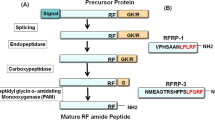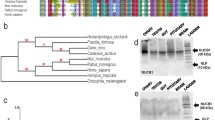Abstract
The insulin-like peptide, relaxin-3 was first identified just a decade ago via a genomic database search and is now recognized to be a key neuropeptide with several roles including the regulation of arousal, stress responses and neuroendocrine homeostasis. It also has significant potential as a drug to treat stress and obesity. Its actions are mediated via its cognate G protein-coupled receptor, RXFP3, which is found in abundant numbers in the brain. However, much remains to be determined with respect to the mechanism of neurological action of this peptide. Consequently, the chemical synthesis of the rat and mouse (which share identical primary structures) two-chain, three disulfide peptide was undertaken and the resulting peptide subjected to detailed in vitro and in vivo assay. Use of efficient solid-phase synthesis methods provided the two regioselectively S-protected A- and B-chains which were readily combined via sequential disulfide bond formation. The synthetic rat/mouse relaxin-3 was obtained in high purity and good overall yield. It demonstrated potent orexigenic activity in rats in that central intracerebroventricular infusion led to significantly increased food intake and water drinking.




Similar content being viewed by others
References
Bathgate R, Samuel C, Burazin T, Layfield S, Claasz A, Reytomas I, Dawson N, Zhao C, Bond C, Summers R, Parry L, Wade J (2002) Human relaxin gene 3 (H3) and the equivalent mouse relaxin (M3) gene: novel members of the relaxin peptide family. J Biol Chem 277:1148–1157
Bathgate RA, Ivell R, Sanborn BM, Sherwood OD, Summers RJ (2005) Receptors for relaxin family peptides. Ann N Y Acad Sci 1041:61–76
Bathgate RAD, Ivell R, Sanborn BM, Sherwood OD, Summers RJ (2006a) International Union of Pharmacology LVII: recommendations for the nomenclature of receptors for relaxin family peptides. Pharmacol Rev 58:7–31
Bathgate RAD, Lin F, Hanson NF, Otvos L Jr, Guidolin A, Giannakis C, Bastiras S, Layfield SL, Ferraro T, Ma S, Zhao C, Gundlach AL, Samuel CS, Tregear GW, Wade JD (2006b) Relaxin-3: improved synthesis strategy and demonstration of its high-affinity interaction with the relaxin receptor LGR7 both in vitro and in vivo. Biochemistry 45:1043–1053
Bathgate RAD, Halls ML, van der Westhuizen ET, Callander GE, Kocan M, Summers RJ (2013) Relaxin family peptides and their receptors. Physiol Rev 93:405–480
Burazin TCD, Bathgate RAD, Macris M, Layfield S, Gundlach AL, Tregear GW (2002) Restricted, but abundant, expression of the novel rat gene-3 (R3) relaxin in the dorsal tegmental region of brain. J Neurochem 82:1553–1557
Chen J, Kuei C, Sutton SW, Bonaventure P, Nepomuceno D, Eriste E, Sillard R, Lovenberg TW, Liu C (2005) Pharmacological characterization of relaxin-3/INSL7 receptors GPCR135 and GPCR142 from different mammalian species. J Pharmacol Exp Ther 312:83–95
Ganella DE, Callander GE, Ma S, Bye CR, Gundlach AL, Bathgate RA (2012a) Modulation of feeding by chronic rAAV expression of a relaxin-3 peptide agonist in rat hypothalamus. Gene Ther. doi:10.1038/gt.2012.83
Ganella DE, Ryan PJ, Bathgate RA, Gundlach AL (2012b) Increased feeding and body weight gain in rats after acute and chronic activation of RXFP3 by relaxin-3 and receptor-selective peptides: functional and therapeutic implications. Behav Pharmacol 23:516–525
Gundlach AL, Smith CM, Ryan PJ, Blasiak A, Olucha-Bordonau FE, Ma S (2013) Relaxin-3 and related relaxin family peptide systems in brain. In: Kastin A (ed) The handbook of biologically active peptides, 2nd edn. Elsevier, San Diego
Haugaard-Kedstrom LM, Shabanpoor F, Hossain MA, Clark RJ, Ryan PJ, Craik DJ, Gundlach AL, Wade JD, Bathgate RA, Rosengren KJ (2011) Design, synthesis, and characterization of a single-chain peptide antagonist for the relaxin-3 receptor RXFP3. J Am Chem Soc 133:4965–4974
Hida T, Takahashi E, Shikata K, Hirohashi T, Sawai T, Seiki T, Tanaka H, Kawai T, Ito O, Arai T, Yokoi A, Hirakawa T, Ogura H, Nagasu T, Miyamoto N, Kuromitsu J (2006) Chronic intracerebroventricular administration of relaxin-3 increases body weight in rats. J Recept Signal Transduct Res 26:147–158
Hisaw F (1926) Experimental relaxation of the pubic ligament of the guinea pig. Proc Soc Exp Biol Med 23:661–663
Hornsby DJ, Wilson BC, Summerlee AJ (2001) Relaxin and drinking in pregnant rats. Prog Brain Res 133:229–240
Hossain MA, Rosengren KJ, Haugaard-Jonsson LM, Zhang S, Layfield S, Ferraro T, Daly NL, Tregear GW, Wade JD, Bathgate RA (2008) The A-chain of human relaxin family peptides has distinct roles in the binding and activation of the different relaxin family peptide receptors. J Biol Chem 283:17287–17297
Hossain MA, Bathgate RA, Rosengren KJ, Shabanpoor F, Zhang S, Lin F, Tregear GW, Wade JD (2009) The structural and functional role of the B-chain C-terminal arginine in the relaxin-3 peptide antagonist, R3(BDelta23-27)R/I5. Chem Biol Drug Des 73:46–52
Hossain MA, Samuel CS, Binder C, Hewitson TD, Tregear GW, Wade JD, Bathgate RA (2010) The chemically synthesized human relaxin-2 analog, B-R13/17 K H2, is an RXFP1 antagonist. Amino Acids 39:409–416
Kuei C, Sutton S, Bonaventure P, Pudiak C, Shelton J, Zhu J, Nepomuceno D, Wu J, Chen J, Kamme F, Seierstad M, Hack MD, Bathgate RAD, Hossain MA, Wade JD, Atack J, Lovenberg TW, Liu C (2007) R3(BDelta23 27)R/I5 chimeric peptide, a selective antagonist for GPCR135 and GPCR142 over relaxin receptor LGR7: in vitro and in vivo characterization. J Biol Chem 282:25425–25435
Li J, Zhang Q, Pang Z, Wang Y, Liu Q, Guo L, Jiang X (2012) Identification of peptide sequences that target to the brain using in vivo phage display. Amino Acids 42:2373–2381
Liu C, Eriste E, Sutton S, Chen J, Roland B, Kuei C, Farmer N, Jornvall H, Sillard R, Lovenberg TW (2003) Identification of relaxin-3/INSL7 as an endogenous ligand for the orphan G-protein-coupled receptor GPCR135. J Biol Chem 278:50754–50764
Liu C, Chen J, Kuei C, Sutton S, Nepomuceno D, Bonaventure P, Lovenberg TW (2005) Relaxin-3/insulin-like peptide 5 chimeric peptide, a selective ligand for G protein-coupled receptor (GPCR)135 and GPCR142 over leucine-rich repeat-containing G protein-coupled receptor 7. Mol Pharmacol 67:231–240
Ma S, Roozendaal B, Burazin TC, Tregear GW, McGaugh JL, Gundlach AL (2005) Relaxin receptor activation in the basolateral amygdala impairs memory consolidation. Eur J Neurosci 22:2117–2122
Ma S, Shen PJ, Burazin TC, Tregear GW, Gundlach AL (2006) Comparative localization of leucine-rich repeat-containing G-protein-coupled receptor-7 (RXFP1) mRNA and [33P]-relaxin binding sites in rat brain: restricted somatic co-expression a clue to relaxin action? Neuroscience 141:329–344
Ma S, Bonaventure P, Ferraro T, Shen PJ, Burazin TCD, Bathgate RAD, Liu C, Tregear GW, Sutton SW, Gundlach AL (2007) Relaxin-3 in GABA projection neurons of nucleus incertus suggests widespread influence on forebrain circuits via G-protein-coupled receptor-135 in the rat. Neuroscience 144:165–190
Ma S, Olucha-Bordonau FE, Hossain MA, Lin F, Kuei C, Liu C, Wade JD, Sutton SW, Nunez A, Gundlach AL (2009) Modulation of hippocampal theta oscillations and spatial memory by relaxin-3 neurons of the nucleus incertus. Learn Mem 16:730–742
McGowan BM, Stanley SA, Smith KL, White NE, Connolly MM, Thompson EL, Gardiner JV, Murphy KG, Ghatei MA, Bloom SR (2005) Central relaxin-3 administration causes hyperphagia in male Wistar rats. Endocrinology 146:3295–3300
McGowan BM, Stanley SA, Smith KL, Minnion JS, Donovan J, Thompson EL, Patterson M, Connolly MM, Abbott CR, Small CJ, Gardiner JV, Ghatei MA, Bloom SR (2006) Effects of acute and chronic relaxin-3 on food intake and energy expenditure in rats. Regul Pept 136:72–77
McGowan BM, Stanley SA, White NE, Spangeus A, Patterson M, Thompson EL, Smith KL, Donovan J, Gardiner JV, Ghatei MA, Bloom SR (2007) Hypothalamic mapping of orexigenic action and Fos-like immunoreactivity following relaxin-3 administration in male Wistar rats. Am J Physiol Endocrinol Metab 292:E913–919
McGowan BM, Stanley SA, Donovan J, Thompson EL, Patterson M, Semjonous NM, Gardiner JV, Murphy K, Ghatei MA, Bloom SR (2008) Relaxin-3 stimulates the hypothalamic–pituitary–gonadal axis. Am J Physiol Endocrinol Metab 295:E278–E286
McGowan BM, Minnion JS, Murphy KG, White NE, Roy D, Stanley SA, Dhillo WS, Gardiner JV, Ghatei MA, Bloom SR (2010) Central and peripheral administration of human relaxin-2 to adult male rats inhibits food intake. Diabetes Obes Metab 12:1090–1096
Otsubo H, Onaka T, Suzuki H, Katoh A, Ohbuchi T, Todoroki M, Kobayashi M, Fujihara H, Yokoyama T, Matsumoto T, Ueta Y (2010) Centrally administered relaxin-3 induces Fos expression in the osmosensitive areas in rat brain and facilitates water intake. Peptides 31:1124–1130
Paxinos G, Watson C (2007) The rat brain in stereotaxic coordinates, 6th edn. Academic press, London
Scholtz JM, Qian H, York EJ, Stewart JM, Baldwin RL (1991) Parameters of helix-coil transition theory for alanine-based peptides of varying chain lengths in water. Biopolymers 31:1463–1470
Shabanpoor F, Separovic F, Wade JD (2011) General method for selective labelling of double-chain cysteine-rich peptides with a lanthanide chelate via solid-phase synthesis. J Pept Sci 17:169–173
Shabanpoor F, Akhter Hossain M, Ryan PJ, Belgi A, Layfield S, Kocan M, Zhang S, Samuel CS, Gundlach AL, Bathgate RA, Separovic F, Wade JD (2012) Minimization of human relaxin-3 leading to high-affinity analogues with increased selectivity for relaxin-family peptide 3 receptor (RXFP3) over RXFP1. J Med Chem 55:1671–1681
Sherwood OD (2004) Relaxin’s physiological roles and other diverse actions. Endocr Rev 25:205–234
Smith CM, Shen PJ, Banerjee A, Bonaventure P, Ma S, Bathgate RA, Sutton SW, Gundlach AL (2010) Distribution of relaxin-3 and RXFP3 within arousal, stress, affective, and cognitive circuits of mouse brain. J Comp Neurol 518:4016–4045
Smith CM, Ryan PJ, Hosken IT, Ma S, Gundlach AL (2011) Relaxin-3 systems in the brain-The first 10 years. J Chem Neuroanat 42:262–275
Smith CM, Hosken IT, Sutton SW, Lawrence AJ, Gundlach AL (2012) Relaxin-3 null mutation mice display a circadian hypoactivity phenotype. Genes Brain Behav 11:94–104
Sudo S, Kumagai J, Nishi S, Layfield S, Ferraro T, Bathgate RA, Hsueh AJ (2003) H3 relaxin is a specific ligand for LGR7 and activates the receptor by interacting with both the ectodomain and the exoloop 2. J Biol Chem 278:7855–7862
Sunn N, Egli M, Burazin TC, Burns P, Colvill L, Davern P, Denton DA, Oldfield BJ, Weisinger RS, Rauch M, Schmid HA, McKinley MJ (2002) Circulating relaxin acts on subfornical organ neurons to stimulate water drinking in the rat. Proc Natl Acad Sci USA 99:1701–1706
Sutton SW, Shelton J, Smith CM, Williams J, Yun S, Motley T, Kuei C, Bonaventure P, Gundlach AL, Liu C, Lovenberg TW (2009) Metabolic and neuroendocrine responses to RXFP3 modulation in the central nervous system. Ann N Y Acad Sci 1160:242–249
Tanaka M, Iijima N, Miyamoto Y, Fukusumi S, Itoh Y, Ozawa H, Ibata Y (2005) Neurons expressing relaxin 3/INSL 7 in the nucleus incertus respond to stress. Eur J Neurosci 21:1659–1670
Wade JD, Lin F, Hossain MA, Dawson RM (2012) Chemical synthesis and biological evaluation of a peptide gonococcal growth inhibitor. Amino Acids 43:2279–2283
Watanabe Y, Miyamoto Y, Matsuda T, Tanaka M (2010) Relaxin-3/INSL7 Regulates the Stress-response System in the Rat Hypothalamus. J Mol Neurosci 43:169–174
Werle M, Bernkop-Schnurch A (2010) Strategies to improve plasma half life time of peptide and protein drugs. Amino Acids 30:351–367
Wilkinson TN, Speed TP, Tregear GW, Bathgate RAD (2005) Evolution of the relaxin-like peptide family. BMC Evol Biol 5:14
Acknowledgments
This research was funded by NHMRC (Australia) project Grants 508995, and 1023078 to JDW, MAH and RADB and 1005988 to ALG and RADB. We are grateful to Tania Ferraro and Sharon Layfield for assistance with biochemical assays and to Feng Lin for amino acid analysis. MAH was the recipient of a Florey Foundation Fellowship and RADB, ALG and JDW are NHMRC (Australia) Research Fellows. Research at the Florey Institute of Neuroscience and Mental Health is supported by the Victorian Government Operational Infrastructure Support Program.
Author information
Authors and Affiliations
Corresponding authors
Rights and permissions
About this article
Cite this article
Hossain, M.A., Smith, C.M., Ryan, P.J. et al. Chemical synthesis and orexigenic activity of rat/mouse relaxin-3. Amino Acids 44, 1529–1536 (2013). https://doi.org/10.1007/s00726-013-1478-0
Received:
Accepted:
Published:
Issue Date:
DOI: https://doi.org/10.1007/s00726-013-1478-0




